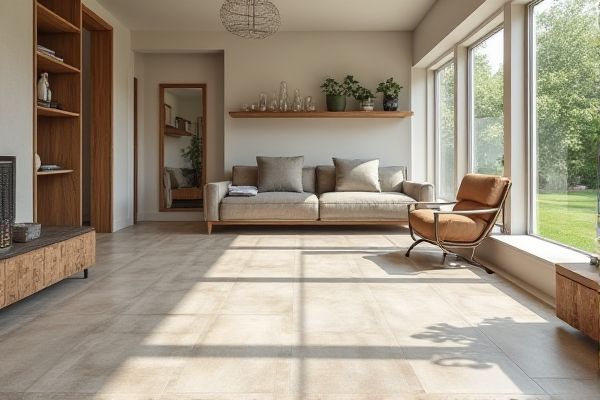
Vinyl flooring offers a budget-friendly, water-resistant option with easy installation and soft underfoot comfort, while tile flooring provides superior durability, long-lasting performance, and a variety of design styles suitable for high-traffic areas. Explore the article to discover which flooring choice best suits your space and lifestyle.
Table of Comparison
| Feature | Vinyl Flooring | Tile Flooring |
|---|---|---|
| Material | Polyvinyl chloride (PVC) | Ceramic, porcelain, or natural stone |
| Durability | Moderate; resistant to scratches and water | High; very durable and scratch-resistant |
| Installation | Easy DIY; click-lock or glue-down options | Professional recommended; requires grout and mortar |
| Maintenance | Low; simple cleaning with mop and mild detergent | Moderate; regular grout cleaning needed |
| Water Resistance | Excellent; ideal for moisture-prone areas | Excellent; fully waterproof when sealed properly |
| Cost | Low to moderate; $2-$7 per sq.ft. | Moderate to high; $5-$15+ per sq.ft. |
| Comfort | Softer and warmer underfoot | Hard and cold; may require underfloor heating |
| Aesthetic Options | Wide range of designs and patterns | Variety of styles; natural stone offers unique looks |
| Lifespan | 10-20 years | 25-50 years or more |
Introduction to Vinyl and Tile Flooring
Vinyl flooring offers a durable, water-resistant surface ideal for kitchens and bathrooms, featuring easy installation and a wide range of styles that mimic natural materials. Tile flooring, made from ceramic or porcelain, provides exceptional hardness and longevity, making it suitable for high-traffic areas and outdoor spaces. Understanding the differences in maintenance, cost, and design options helps you choose the best flooring for your needs.
Material Composition and Construction
Vinyl flooring is composed of multiple layers, including a durable wear layer, a printed design layer, and a flexible core made from polyvinyl chloride (PVC), offering water resistance and comfort underfoot. Tile flooring, typically made from ceramic or porcelain clay, is fired at high temperatures to create a hard, dense surface that resists moisture, scratches, and heat. Your choice depends on the desired durability and maintenance level, with vinyl providing softer, warmer flooring and tile delivering a long-lasting, rigid surface ideal for heavy traffic areas.
Installation Process Compared
Vinyl flooring offers a simpler and faster installation process than tile flooring, often requiring only adhesive or a click-lock system suitable for DIY projects. Tile flooring installation involves more complex steps like mortar application, precise grout lines, and curing times, making it more labor-intensive and typically requiring professional expertise. Your choice depends on whether you prefer quick installation and flexibility or the durability and design options provided by tile.
Durability and Lifespan
Vinyl flooring offers excellent durability with resistance to scratches, stains, and moisture, making it ideal for high-traffic and wet areas, and typically lasts 10 to 20 years. Tile flooring, especially ceramic and porcelain types, provides superior longevity and can endure decades with proper maintenance, often exceeding 50 years without significant wear. Both materials vary in lifespan depending on quality, installation, and usage conditions, but tile flooring generally outperforms vinyl in long-term durability.
Maintenance and Cleaning Requirements
Vinyl flooring offers lower maintenance with its water-resistant surface that requires simple sweeping and occasional mopping, making it ideal for busy households. Tile flooring demands more rigorous upkeep, including regular grout cleaning and sealing to prevent stains and moisture damage. Your choice between vinyl and tile should consider the time and effort you're willing to invest in maintaining a durable, clean floor.
Water and Moisture Resistance
Vinyl flooring offers superior water and moisture resistance due to its non-porous surface, making it ideal for bathrooms and kitchens where spills and humidity are common. Tile flooring also provides excellent moisture resistance but may require proper grout sealing to prevent water infiltration and mold growth. For your space prone to damp conditions, vinyl ensures a more seamless and maintenance-free barrier against moisture.
Design, Style, and Aesthetic Options
Vinyl flooring offers a wide range of design and style options, including realistic wood, stone, and tile patterns that can mimic high-end materials at a lower cost. Tile flooring provides a diverse palette of colors, shapes, and textures, allowing for intricate mosaic designs and classic or contemporary aesthetics with materials like ceramic, porcelain, and natural stone. Both vinyl and tile flooring can complement various interior design themes, but vinyl's flexibility suits modern, casual spaces, while tile is preferred for durable, timeless elegance in kitchens and bathrooms.
Comfort and Underfoot Feel
Vinyl flooring offers a softer, more cushioned underfoot feel compared to tile, making it more comfortable for prolonged standing or walking. Tile flooring tends to be harder and colder, which can be less comfortable without added rugs or underfloor heating. The flexibility of vinyl helps absorb impact, reducing strain on joints and providing a warmer surface temperature than tile.
Cost Analysis and Value for Money
Vinyl flooring generally offers a lower upfront cost compared to tile flooring, making it an attractive option for budget-conscious projects. Tile flooring, while more expensive initially, provides superior durability and longevity, often resulting in better long-term value for money. Your choice should consider installation costs, maintenance expenses, and the expected lifespan to determine the most cost-effective flooring solution.
Eco-Friendliness and Sustainability
Vinyl flooring typically contains synthetic materials and chemicals that can be less eco-friendly due to production emissions and limited recyclability, whereas tile flooring, especially natural stone or ceramic, is often more sustainable with longer lifespans and higher recyclability. Tiles contribute to lower indoor air pollution and can be sourced from abundant natural materials, reducing environmental impact over time. For your eco-conscious home, choosing tile flooring supports sustainability goals through durability and reduced waste.
 homyna.com
homyna.com